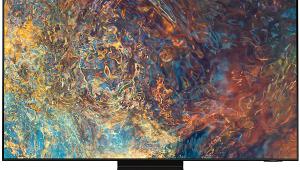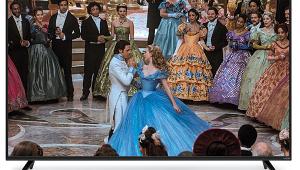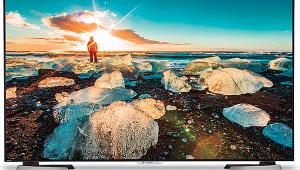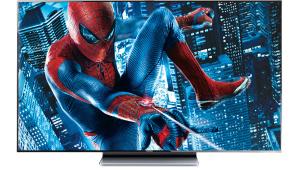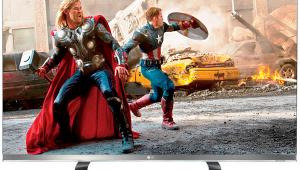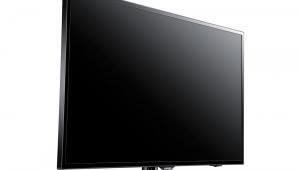Samsung LN55A950 LCD TV Real-World Performance
Having seen a lot of TVs over the years, my wife no longer pays much attention as new ones come and go from our family room. The first time she saw this Samsung, however, it elicited an immediate reaction. "Wow, would you look at that," I heard her say. "What a great picture! What kind of TV is this?"
Her reaction is understandable, because once it's properly adjusted, the LN55A950 really does look spectacular. The set's huge contrast ratio, natural color palette, and razor-sharp detail combine to create a punchy, looking-out-the-window picture that reaches right out and stops you in your tracks. That's the good news. The Samsung is not without some drawbacks, of course, but these are not so obvious until you've lived with the TV for a while. I might as well get these out of the way first.
As I said earlier, the LN55A950's claim to fame is it's LED backlighting with local dimming, in which the individual LEDs that form the backlight grid are dimmed or turned off in dark areas of the picture. Local dimming happens in real time, and the trick is to make it happen in such a way that the viewer doesn't notice that the black level in different parts of the picture is constantly changing.
This is no mean feat, because the number of LED backlight elements is much lower than the number of pixels on the screen (thousands versus millions). As a result, backlit areas tend to be somewhat larger than the pixels they are illuminating. This results in two picture problems—bright objects set against a dark background can be surrounded by a halo of light, and the brightness of the objects themselves can pump up and down as the surrounding LEDs dim.
Given the right (or should I say wrong?) material, the Samsung demonstrated both problems. Some obvious examples can be seen in Stargate: Continuum on Blu-ray. The opening title sequence, for example, consists of white text that fades in and out against what should be a stable star-field background. As the text comes and goes, the stars in the background dim and brighten in response.
Similarly, chapter 3 opens with shot of a dimly lit ship sailing on a dark night. At first, all you can make out is a vague outline of the ship and its bridge lights. Then, a few seconds in, a white title appears to inform you that the scene is the "Atlantic Ocean, 1939." When the title appears, you can suddenly see details on the ship such as fittings, railings, etc. When the title disappears, so do the details. An almost identical situation occurs in the opening sequence of Master and Commander, and indeed in any sci-fi flick where a brightly lit spaceship appears against a black star field.
The light-pumping effect was quite obvious when I first tried to set up my early production sample, which, as I mentioned earlier, had an incorrect setting in its service menu that caused the local dimming to behave too aggressively with dark scenes. Correcting the parameter vastly improved things, but it did not totally eliminate the problem. And even with the correct setting in place (all sets shipped by the time you read this will have the correct setting), the pumping effect became extremely pronounced if the TV's brightness control was adjusted to any setting other than 63—one click higher or lower was all it took.
White credits against a black background are not uncommon if you watch many films, and on the Samsung, they provide a good demonstration of local dimming's haloing effect. Instead of sharply etched characters, each credit is surrounded by a nimbus of light. The effect is even visible when my Pioneer Blu-ray player starts up and displays a bright-red company logo in the center of the screen—in this case, the halo appears in red. Furthermore, when a credit disappears, the halo takes a split second longer to wink out, appearing to shrink and then blink out, sometimes producing a subtle flash as it disappears.
LCD TVs are not known for their exceptional off-axis performance—that's one area where plasmas get the nod. I found the LN55A950's off-axis performance to be worse than most, partly because the haloing effect becomes much more pronounced when you view the screen from the side. This exacerbates the usual LCD off-axis problems of discoloration and increased black level to the point where I can't recommend this set unless all viewers will be watching from front and center.
While the haloing and light-pumping effects are relatively subtle and happen only infrequently, the glare and reflections caused by the set's ultra-shiny screen surface and reflective glass bezel are a constant annoyance. This is a real shame, because this TV's pitch-dark blacks and ample light output would otherwise make it a perfect choice for daytime or lights-on viewing. As it stands, the set is almost unwatchable in rooms with lots of windows or lights that fall anywhere within the screen's zone of reflection.
Manufacturers like to insist that crystal-clear screens improve contrast and/or color, but I just don't buy it. Any negligible improvements attributable to the screen's surface finish will be completely overwhelmed by the glare and reflection problems that inevitably result from a shiny surface. Give us matte-finish screens, please!
Now that we've got the bad news out of the way, it's time for the good news. And lest I leave you with the wrong impression, let me emphasize that for the vast majority of viewers, this TV's good points far outweigh its drawbacks.
It's hard to overstate the impact that true blacks have on the Samsung's overall picture quality. A blank screen on this TV is totally, utterly black, not dark gray as it is on just about every other flat-panel display on the market. In fact, the only way you can tell the set is still on is by the absence of the little red standby light on the lower right corner of the bezel (or the glowing blue bar below the screen center, which I always turn off). Letterbox bars completely disappear as well.
After living with this TV for a while, switching back to a regular LCD or plasma display is going to feel like someone has removed the subwoofer from my audio system—the bottom is going to drop out. I can't really point to any specific scenes that illustrate what I'm taking about, because the impact of having perfect blacks is felt constantly on everything you watch. What strikes me most about the picture is its punchy, vividly real look—that's what stopped my wife in her tracks the first time she caught a glimpse of this TV. There's simply more "there" there.
With such deep blacks, I was concerned that shadow details might clog up and be rendered as black blobs. Providing the black level is set correctly (at exactly 63 on my sample), this is not the case. Shadow detail is excellent, as evidenced by the below-deck walk in the opening scene of Master and Commander. As the officer makes his way between the swaying hammocks, the lantern he carries illuminates details within a small area. I could easily make out textures and details in the wood deck and beams, read the names inscribed on the cannon, and—for the first time in my case, and I've watched this scene dozens of times—notice that the animals whose eyes glow back at you out of the darkness include a sheep, a goat, and a cow.
Colorful, brightly lit HD material such as a football game or an animated movie like Cars looks absolutely sensational on the LN55A950. The color reproduction on this TV is among the best I've seen. Reds, in particular, are fully saturated but not overblown—Lightning McQueen has never looked better.
And I must say it has been so long since I've seen accurate greens from a flat-panel display, I almost forgot what a grass playing field looks like. (Hint: it doesn't fluoresce or appear so oversaturated that you wouldn't be surprised to see it glow in the dark.) Because large swaths of green are so common in material ranging from golf championships to episodes of Nature on PBS, the ability to reproduce accurate greens cannot be overrated in my book.
One of my touchstones for color reproduction is the BBC documentary series Planet Earth. In particular, I like to view the "Shallow Seas" episode of this beautifully produced Blu-ray to see how a set handles subtle shades of blue as well and smooth gradations from light to dark. On the Samsung, the scenes of a humpback mother and calf sporting in crystal-clear tropic waters were so noise-free and realistic, I felt as though I was right there, watching through some magic glass window in the middle of the ocean.
Shafts of sunlight radiate downward from the light-blue surface above, while below, the waters shade ever darker into the depths. On less-effective displays, the continuous and continuously moving shades of blue in these scenes appear "solarized," showing unrealistic, discrete bands of color where there should be smooth gradations from light to dark. There was no hint of solarization here.
Thanks to its combination of Auto Motion Plus frame interpolation and LED Motion Plus, the LN55A950's ability to maintain detail during fast motion scenes—a real weakness with most LCD displays—is on a par with the best plasmas. The Cars Blu-ray has layer upon layer of carefully rendered details that show up in both stationary and high-velocity scenes. As the camera zips and pans around the action in the opening Piston Cup race sequence, you can make out details in the "crowd," which consists of tiny cars that jump up and down and wave flags and colorful race souvenirs. You can see the grid of the wire fence as it whizzes past, and even read decals on the moving cars. The crystalline clarity of the Samsung's picture enables you to eke out new details with every viewing. For example, I just noticed that Chick Hicks is sponsored by "htB"—Hostile Takeover Bank. You gotta love that! Motion blur is simply not an issue on this TV.
